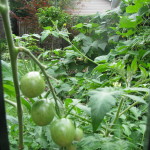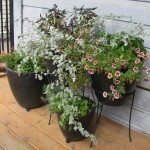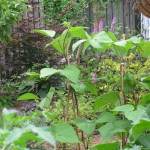Growing fruits, vegetables, herbs and edible flowers is possible, even where small spaces are available in your garden, deck, balcony and home. New varieties of tomatoes and other plants, which can grow in containers and smaller spaces, are now available. Also, there is a new appreciation of the colour, texture, and overall appearance of some edibles so that they can replace more standard flowering annuals in the garden or be interspersed among them – plus provide fresh flavours and nutrition.
Gardening Practices:
Rotating Crops Through Gardening Season – If there is small space, it makes sense to grow a series of plants in the spring, summer and fall according to whether they are cool or heat loving plants. Thus cool-loving plants which are harvested early in the spring, such as snow peas, onions, cress or lettuces, can be followed in the late spring/summer by heat-loving plants such as tomatoes and peppers, which in the fall are replaced by cool season plants, such as pansies or leeks.
Companion Planting or Splendid Isolation – Some plants grow better if they are grown together, as in the indigenous tradition of the “Three Sisters”. Single marigolds repel insects from other plants. Tomatoes, when grown near basil, have higher yields. Parsley and onions help repel the carrot fly and are examples of many other companion plant combinations.
Conversely, dill and cilantro can be cross-pollinated with each other, ruining both. Strong aromatic herbs and cucumbers are not good companions, along with some other combinations. Invasive plants, such as mint and strawberries, are often best contained in their own tubs in the garden. Tubs and containers, especially on decks, can isolate plants from some hungry insects and animals. Finally, take care that edibles are not grown near plants with poisonous parts, such as English ivy and caladium, especially if young children are around.
Regulating Moisture –Even moisture is especially important for many edibles, such as tomatoes, cucumbers and lettuce. Natural mulches can be spread around plants to help the soil retain moisture. Avoid mulches with chemicals that can leach into the soil, such as dyed mulches. Drip irrigation systems and self-watering tubs and green walls can direct water to the roots where it is most needed and away from leaves where fungal diseases can take hold.
Harvest Often – Sprigs of herbs, leaves and flowers can be snipped often during their growing season to add to meals. Also, several crops of vegetables can be grown when new seeds are planted weekly for a longer supply of carrots, radishes, salad green or other plants.
Spaces and Containers:
Trellises, Fences and Other Supports – Climbing plants and vines, such as pole beans, cucumbers, nasturtiums and some roses, as well as tomatoes which become laden with heavy fruit, need supports. By growing vertically, these plants have more space to grow and allow other nearby plants more room. The supports allow better air circulation which suppresses some diseases such as mildew.
Raised Beds – Wooden frames can be made easily with kits or put together by those with some carpentry skills. Non-treated wood needs to be used when growing edible plants.
Raised beds allow more space for roots. Soil is warmer in these beds and so faster growth is possible, especially for heat-loving plants. Plants can be started earlier in the spring, with weeks added to the growing season. Convenience for weeding and plant tending are among the additional benefits.
Containers –Available in all sorts of materials, colours and sizes, containers offer lots of flexibility for growing edible plants. They can be shifted in the garden so that edible plants, which generally prefer full sun, can get the light that they need. Soil conditions are easier to modify in a container than a garden, so sand can be added for well-drained soil for many herbs or a peat-moss based medium used in tubs for blueberry plants for the patio. Heat-loving plants, such as tomatoes, peppers, cucumbers, grow faster in dark or metal containers since their roots are kept warmer.
Various combinations of edible plants can be grown in containers: some might be based on specific cuisines; particular colours can be featured, such as red, purple or yellow; or there can wonderful visual and taste creations.
Green Walls – Different containers are available to allow plants to grow on outside and indoor walls. These range from decorative pots for a few herbs to self-watering and lighted gardens for fresh herbs and greens.



